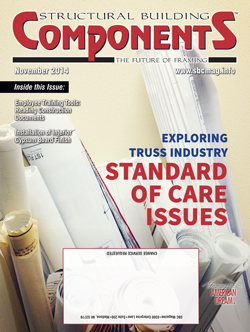Unifying the Framing Industry Through Safety
Unifying the Framing Industry Through Safety
The construction industry is a fragmented lot. This isn’t always a bad thing. However, when it comes to jobsite safety, fragmentation creates obstacles that shouldn’t be there (and don’t have to be). That is why, when a few of us first came together last fall to create SBCA’s National Framers Council (NFC), we decided to begin by focusing all of our efforts on creating a standardized safety program for framers. If there is one thing that will dramatically improve the framing process, and make it a more attractive occupation for young people, it’s making the jobsite a safer place to work.
One year later, I’m proud to announce that our safety program, FrameSAFE™, is finally complete and available to framers. Our first goal with FrameSAFE is to raise awareness of the importance of safety on the jobsite. NFC’s mission is “to help ensure framers leave the jobsite each day in the same health as they arrived.” Just as in your manufacturing facilities, establishing a culture of safety begins with thorough and effective communication of potential injury risks and expectations for safe behavior.
Our second goal with FrameSAFE is to provide a standardized approach to safety communication. A standardized approach allows for more universal adoption across the country. One of the greatest hindrances, due to fragmentation, is that each framing crew needs to have its safety plan approved by the general contractor (GC) on each job. In practice, this has led large framing companies like mine to develop our own safety program. Other large framers have done likewise, creating programs that are essentially the same, but different in one way or another. On the other end of the spectrum, many small framers do not develop a safety program at all, but rather follow the GC’s overall safety program as a guide.
It’s very difficult to develop a good culture of safety when your safety plan changes from jobsite to jobsite. It’s also hard to develop a high level of expectation about safe behavior when requirements and enforcement aren’t consistent. Through FrameSAFE, every framer, regardless of size, has the opportunity to adopt the same safety protocols and standardized procedures.
Our third goal with FrameSAFE is to share universal best practices when it comes to safe behavior and jobsite hazard mitigation. Framing can be a dangerous occupation. The more we can take the guesswork out of the best way to address injury risks, the better off our framers and our industry will be. At the same time, FrameSAFE establishes a higher expectation for every framer to meet. This program makes it clear you can’t shortchange safety; the consequences are too serious.
Hopefully, FrameSAFE will be successful at achieving these goals through a well-developed training approach. At its foundation, the program is based on established best practices and good information. While the program binder is full of text, which can be very valuable for safety coordinators and foremen to get all the background information, a large part of the program is dependent on images. Just like yours, our industry is multilingual.
Even English/Spanish translations can only go so far communicating important safety information. That’s why FrameSAFE has hundreds of photos to visually show correct behavior or point out potential injury hazards. Pictures are very important. In addition to the core safety information, training is also broken up into bite-sized pieces called Toolbox Talks. These single-page training sessions give jobsite foremen a structured way to provide quick refresher training on the jobsite whenever it’s convenient.
Finally, in the event of an accident that results in an injury or property damage, FrameSAFE provides standardized reporting guidance and forms to complete. Standardized reporting will have several advantages. Not only will complete information be collected at the time of an accident, but it will also be standardized in a way that will allow us to create a national database to track trends and identify areas to provide additional training.
Why am I telling you all of this? FrameSAFE presents a few major benefits to component manufacturers. First, standardizing jobsite safety for framers and raising the expectations for safe behavior is a good thing for the components industry. For instance, when my company looks at constructing a building from a safety and cost-effective standpoint, we componentize as much as possible. Components limit my framers exposure to fall risks at the leading edge.
For example, with panelized walls, my framers don’t have to spend time building rough openings at the building’s exterior. The same goes for roofs; installing roof trusses exposes my framers to fall risks a fraction of the time compared to conventional framing. In this day and age, with OSHA visiting jobsites and frequently issuing citations related to improper or inadequate fall protection, components are the best solution.
Second, as we improve the level of safety on the jobsite and push safe behavior as the norm, more people will choose framing as a career. The more framers in the field, the more individuals to install your products and the more jobs will get done.


